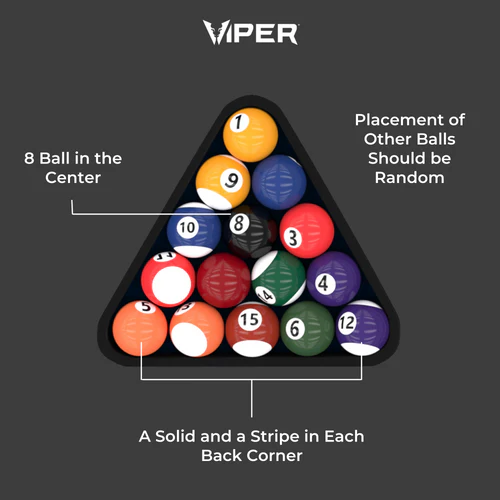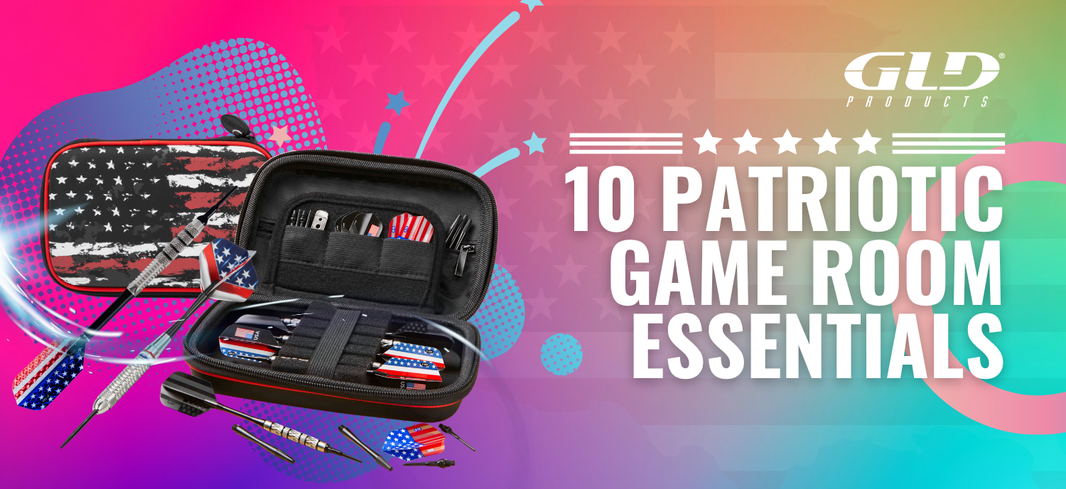The most widespread game of pool, also known as, stripes and solids, pocket billiards, and 8 ball pool.
Eight-ball, sometimes called stripes and solids, or pocket billiards, is the most common game of pool played today. The name is a reference to how many balls need to be pocketed to win the game, but all 15 balls are used.
All of the striped and colored balls are referred to as object balls, and the solid white ball is the cue ball. Each player alternates turns, called innings. And the goal of Eight-Ball is to pocket 7 object balls of one type, either striped or solid, followed by the eight ball.
Number of Players
Eight-ball pool can be played with two players, or two teams of two.
How to Play
Racking Up
To play Eight-Ball, we first need to go over how to rack the pool balls and set up the table.
To rack a game of 8 ball, all 15 object balls are placed as tightly as possible into a triangular rack on the table. Each of the back corners should have a solid and stripe in them, while the eight ball is in the center. The placement of the other balls doesn't matter but it should be random. See the diagram below for how to rack billiard balls.

After the balls have been racked, the ball in the front of the triangle should be placed on top of the foot spot. The foot spot is in the center of the foot string which is an imaginary line between the second set of diamonds on the far side of the table. The triangle should point towards the opposite side, or head, of the table (see diagram below). The triangular rack is then carefully removed and play can begin.

Lag for Break - BCA Official Rule
You can determine play order however you want, but the official way to determine turn order in 8 ball is a lag for the opening break. To do this, each player gets a ball of equal size and weight, preferably two cue balls but two solids or stripes will work too.
Each player stands next to each other behind the head rail and places their ball behind the head string. The head string is an imaginary line between the second pair of diamonds (see above diagram).
Both players then shoot their ball at the foot rail, bouncing it back towards them. Whoever's ball gets closer to the head rail goes first. A player automatically loses the lag for break if their ball does any of the following:
If both players lose the lag for break, or if there is no clear winner, then it is considered a tie and it is redone until someone wins. Whoever wins chooses who goes first.
The Break
The player who is going first will set the cue ball anywhere they want behind the head string. This area is often called "the kitchen".
They then hit the cue ball into the object balls causing them to scatter. The goal during the break is to get the balls to spread out evenly. This will make it easier to pocket the balls.
After the Break
The goal of Eight-Ball pool is to pocket all of one type of object ball, either solids or stripes, and then the eight ball. Once the break is complete, the table is "open" and whoever pockets an object ball first is assigned that type of ball, solids or stripes, for the rest of the game.
The table is considered open after the break even if one or multiple balls are pocketed during it. However, if a ball is pocketed during the break, the player who performed the break is able to go again.
Every time a player pockets an object ball that is part of their target group, they can continue shooting. However, as soon as a player misses, fouls, or scratches, their turn is considered over - more on fouls and scratches later.
Winning
A player wins Eight-Ball after sinking all of their object balls and then the eight-ball. A player also can win if their opponent performs certain fouls on the eight ball shots (see below under "The 8 Ball and Automatic Losses").
Additional Rules, Fouls, Illegal Shots, and Automatic Losses
The following rules are based on the Billiard Congress of America's (BCA) official rule set.
Scratch
A scratch is when a player pockets the white cue ball at any point during their turn. When this happens, the player who goes next gets a "ball in hand". A ball in hand allows a player to place the cue ball anywhere on the table before making their shot.
The exception to this is if a player scratches on the break. If they do, then the other player can place it anywhere behind the head string to take their shot. They also cannot aim at any ball behind the head string.
If a player touches any object ball with the cue ball or their hand when placing it, then it is a foul and the other player gets a ball in hand.
The 8 Ball and Automatic Losses
There are multiple rules that are specific to what must happen when pocketing the eight ball.
When shooting the eight ball, whoever is shooting must declare what pocket it will go into, either by pointing or saying which pocket. If the eight ball goes into a different pocket, the game ends and the person who pocketed it loses.
Note: If the eight ball is pocketed during the break, instead of it being considered a loss, the balls are re-racked and the player breaks again.
If a player scratches after pocketing the eight ball, they automatically lose. If they scratch, but the eight ball isn't pocketed, they do not lose and the game continues like it normally would after a scratch.
If the eight ball ends the round anywhere besides the playing surface of the table, it is an automatic loss.
Rules for Striking the Cue Ball
There are multiple rules to keep in mind when it comes to hitting the cue ball. The first is that only the tip of the cue is allowed to hit the cue ball. Anything else is a foul and ends the player's turn. Hitting the cue ball twice, or any object ball once, with any part of the cue is also a foul.
Push shots are fouls. A push shot is when the cue remains in contact with the ball longer than the brief moment needed to hit it.
Jumping the Ball
There are two ways to jump a ball in cue. The first is when the cue strikes the lower half of the ball and the cue "digs under" the ball to raise it off the table. This is a foul when done intentionally. If done accidentally then it is not an immediate penalty, but if another foul occurs - such as hitting the ball with the ferrule - then it is still an illegal move.
The other way to jump the ball is by hitting the ball from a higher angle so that it rebounds from the force of it being struck against the bed of the table. This is a legal move.
Regardless of how the ball is jumped, if it comes to a rest anywhere besides the bed of the table, it is a foul. This includes the rails, cushions, floor, or anywhere else. If the ball lands on the top of the cushions or rails but then returns to the table on its own, then it is a legal hit.
If the ball touches anything that isn't part of the table or an object ball, then it is a foul. This includes light fixtures, the room, or even chalk that might be resting on the side of the table.
Hitting Your Opponent's Balls
When playing by official rules, you are not allowed to hit your opponent's object balls first when taking a shot. For example, if you are solids and your opponent is stripes, the cue ball needs to contact a solid ball before hitting a striped.
In this situation, if the cue ball hits a striped ball first and you pocket a solid, then the ball remains pocketed. However, your turn would immediately end.
Double Hit
A double hit is simply when the cue stick hits the cue ball twice during a stroke. When this happens, it is a foul and the player's turn ends.
Call Shot
Call-Shot is an optional way to play where players need to declare which ball is going into which pocket. Obvious shots do not need to be declared, however, bank and combination shots are not considered obvious and must always be called out.
Players do not need to call any maneuvers that the ball is going to take. They also don't need to declare any other balls that are pocketed, as long as the originally called ball goes into the correct pocket.
This is how official games are played.
Additional Notes
This is by no means an exhaustive list of rules and regulations for how to play eight ball. But this does cover the majority of the rules and the most common situations you will encounter during a game.
As we said, this is based on the Billiard Congress of America's ruleset. The American Poolplayers Association (APA) and World Pool-Billiard Association (WPA) both have slightly different variations of these rules. These differences typically have to do with how certain fouls are handled during gameplay.
If you'd like to look at the unabridged rules for each organization, use the links below:







